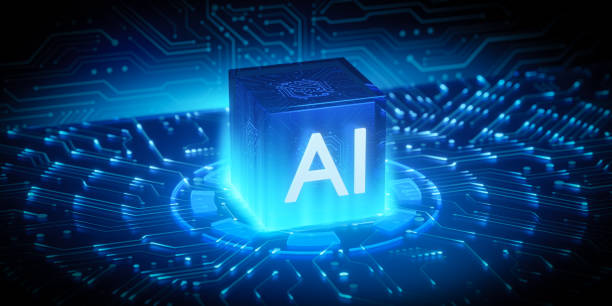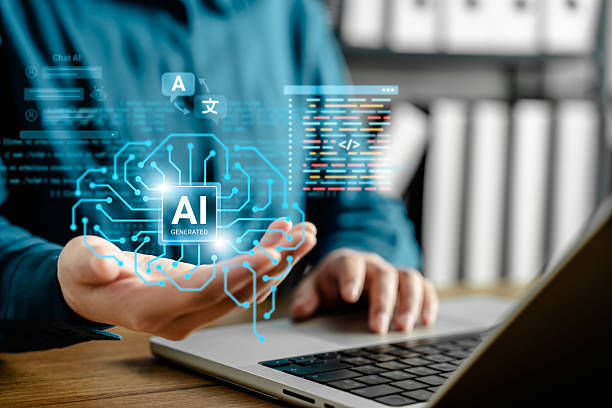What is an artificial intelligence robot and what are its applications?
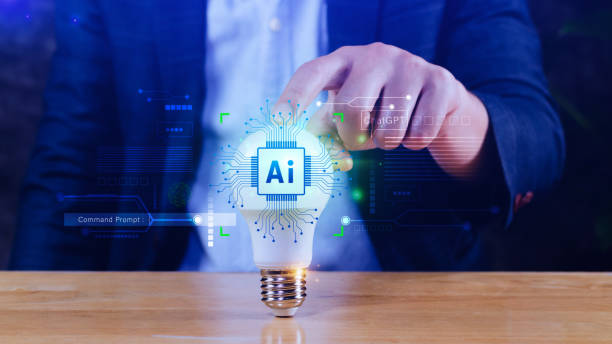
What is an artificial intelligence robot and what are its applications?
An artificial intelligence robot is a combination of two technologies: robotics and artificial intelligence.
In simple terms, these robots are machines that are capable of performing tasks that usually require human intelligence.
These tasks include learning, problem-solving, decision-making, and natural language understanding.
AI robots analyze their surroundings using complex algorithms and vast amounts of data and act accordingly.
The applications of AI robots are vast and varied.
These include:
- Industry: On production lines, for performing repetitive and dangerous tasks, AI robots can work with high accuracy and speed.
- Medicine: In precise surgeries, disease diagnosis, and providing healthcare, AI robots play an important role.
For example, the Da Vinci Surgical System is an example of this application. - Customer Service: In answering customer questions, providing technical support, and conducting financial transactions, chatbots and AI robots are widely used.
- Agriculture: In harvesting crops, smart irrigation, and farm management, AI robots can increase productivity.
- Education: In providing personalized education and answering student questions, AI robots can play the role of a private tutor.
In short, an AI robot is a powerful tool that can help improve efficiency, accuracy, and quality of life in various fields.
This technology is still under development and is expected to play a more prominent role in our lives in the future.
Does your current website convert visitors into customers or scare them away? Solve this problem forever with professional corporate website design by Rasaweb!
✅ Creating strong credibility and branding
✅ Attracting target customers and increasing sales
⚡ Get a free consultation now!
Main components of an AI robot
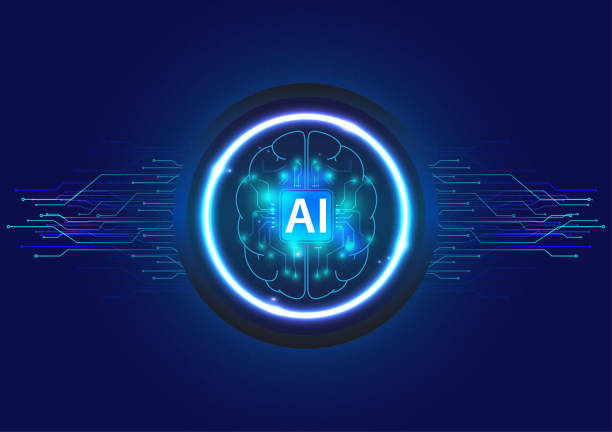
Main components of an AI robot
An AI robot consists of several main parts, each of which plays an important role in its overall performance.
These components include:
- Sensors: Sensors are tools that collect information from the environment.
This information can include images, sounds, temperature, pressure, and other relevant data.
Sensors help the robot become aware of environmental conditions and act accordingly.
There are different types of sensors, such as cameras, microphones, touch sensors, and proximity sensors. - Processor: The processor is the brain of the robot and is responsible for processing the data received from the sensors and making decisions.
The processor uses artificial intelligence algorithms to analyze data and extract patterns.
The power of the processor directly affects the speed and accuracy of the robot in performing tasks. - Actuators: Actuators are tools that enable the robot to interact with the environment.
These tools can include motors, pistons, robotic arms, and other movement mechanisms.
Actuators operate based on the processor’s commands and allow the robot to move, move objects, and perform physical tasks. - Software: Software includes artificial intelligence algorithms, control programs, and user interface.
AI algorithms help the robot learn, solve problems, and make decisions.
Control programs are responsible for managing the robot’s performance and coordinating between different components.
The user interface allows humans to communicate with the robot and give it the necessary commands. - Power Source: The power source provides the energy needed for the robot to function.
This source can include batteries, fuel cells, or a direct connection to electricity.
The type of power source affects the robot’s operating time and portability.
By combining these components, an AI robot will be able to perform complex tasks automatically and help humans in various fields.
Types of AI robots based on application

Types of AI robots based on application
AI robots are divided into different types based on their application.
Each type of these robots is designed to perform specific tasks and has unique features.
Some of the most important types of AI robots are:
- Industrial Robots: These robots are used on factory production lines to perform repetitive, heavy, and dangerous tasks.
They usually have robotic arms that can move and assemble parts with high accuracy and speed.
Industrial robots play an important role in increasing productivity and reducing costs in the industry. - Medical Robots: These robots are used in hospitals and medical centers to perform precise surgeries, help the disabled, and provide healthcare.
They can make small incisions with high precision, accurately prescribe medications, and assist patients in performing rehabilitation exercises. - Service Robots: These robots are used in public places such as hotels, restaurants, and airports to provide services to customers.
They can provide information, register orders, serve food, and help customers find their way. - Agricultural Robots: These robots are used in farms and greenhouses to perform tasks such as planting, irrigating, harvesting crops, and controlling pests.
They can plant seeds with high precision, use water optimally, and use fewer pesticides. - Military Robots: These robots are used in armies and security forces to perform tasks such as reconnaissance, bomb disposal, patrolling, and combat.
They can operate in dangerous and inaccessible conditions for humans and reduce casualties.
In addition, AI robots are also used in other fields such as education, entertainment, space exploration, and scientific research.
With the advancement of technology, it is expected that the applications of these robots will expand and play a more important role in our lives.
| Robot Type | Application | Example |
|---|---|---|
| Industrial | Production lines | Assembling car parts |
| Medical | Surgery | Da Vinci Surgical System |
| Service | Customer service | Chatbots |
| Agricultural | Smart agriculture | Harvesting crops |
Challenges and limitations of AI robots

Challenges and limitations of AI robots
Despite the many advantages, AI robots also face challenges and limitations that need to be addressed:
- Cost: Designing, building, and maintaining AI robots is usually expensive.
This cost includes purchasing parts, hiring specialists, and developing software.
Therefore, the use of these robots in some industries and applications may not be cost-effective. - Complexity: AI robots are complex systems that require high expertise and technical knowledge for design, planning, and maintenance.
This complexity can cause problems in the robot’s performance and increase the time and cost of repairs. - Security: AI robots may be vulnerable to cyber attacks and their information may be stolen or tampered with.
This can lead to serious damage to organizations and individuals. - Ethics: The use of AI robots in some cases may raise ethical issues.
For example, if an AI robot is at fault in a car accident, who will be responsible? Or if an AI robot decides to kill a human, what should be done? - Employment: The widespread use of AI robots may lead to job losses for some people.
This can cause social and economic problems. - Dependence: Over-reliance on AI robots can reduce human skills and increase vulnerability to unforeseen events.
To address these challenges and limitations, more research is needed in the field of artificial intelligence, appropriate laws and regulations need to be developed for the use of this technology, and necessary training needs to be provided to individuals.
Are you worried about losing customers who don’t have a professional online store?
Forget those worries with online store design by Rasaweb!
✅ Significant increase in sales and visitor-to-customer conversion rate
✅ Professional and user-friendly design that builds customer trust
⚡ Get a free consultation from Rasaweb
What will the future of AI robots be?

What will the future of AI robots be?
The future of AI robots is very bright and full of possibilities.
With the advancement of technology, these robots are expected to become smarter, more efficient, and more reliable and help humans in various fields.
Some of the most important future trends in the field of AI robots are:
- Deep Learning: Deep learning algorithms help robots learn from vast amounts of data and perform more complex tasks.
These algorithms can be used in areas such as facial recognition, natural language processing, and self-driving. - Internet of Things: Connecting robots to the Internet of Things (IoT) allows them to communicate with other devices and systems and share information.
This can lead to the creation of smarter systems that are capable of performing complex tasks in a coordinated manner. - Human-Robot Collaboration: In the future, humans and robots are expected to collaborate more with each other.
Robots can perform repetitive and dangerous tasks, and humans can focus on creative and strategic tasks. - Autonomous Robots: Autonomous robots will be able to perform their tasks without the need for human intervention.
These robots can be used in areas such as transportation, agriculture, and space exploration. - Emotional Robots: Emotional robots will be able to understand and respond to human emotions.
These robots can be used in areas such as elderly care, education, and therapy.
In general, the future of AI robots is very promising, and this technology is expected to play an important role in our lives.
However, ethical and social issues related to this technology also need to be addressed to ensure its responsible and safe use.
The role of AI robots in industry

The role of AI robots in industry
AI robots play a very important role in the transformation of industry.
These robots can increase productivity, reduce costs, and improve the quality of products by performing repetitive, dangerous, and laborious tasks.
Some of the most important applications of AI robots in industry are:
- Automation: AI robots can automate production processes.
This can lead to increased production speed, reduced human error, and reduced costs. - Quality Control: AI robots can accurately and continuously control the quality of products.
This can lead to reduced waste, increased customer satisfaction, and improved brand reputation. - Maintenance and Repairs: AI robots can continuously monitor the condition of machinery and equipment and identify problems before they cause breakdowns.
This can lead to reduced production downtime, reduced repair costs, and increased service life of machinery. - Supply Chain Management: AI robots can optimally manage the supply chain.
This can lead to reduced transportation costs, reduced inventory, and increased product delivery speed. - Safety: AI robots can perform dangerous tasks instead of humans.
This can lead to reduced work accidents, reduced injuries, and improved working conditions.
The use of AI robots in industry can lead to increased competitiveness of companies, the creation of new job opportunities, and improved economic conditions.
However, it is necessary to provide necessary training to employees so that they can work with these new technologies and benefit from them.
Case study of AI robots in medicine

Case study of AI robots in medicine
AI robots are creating significant changes in the field of medicine.
These robots can be used in various fields such as disease diagnosis, surgery, rehabilitation, and patient care.
Some of the most important applications of AI robots in medicine are:
- Disease Diagnosis: AI robots can analyze medical images with high accuracy and diagnose diseases in the early stages.
This can lead to faster and more effective treatment of diseases.
For example, AI robots can diagnose lung cancer with greater accuracy than radiologists. - Surgery: AI robots can perform precise and minimally invasive surgeries.
This can lead to reduced bleeding, reduced pain, and reduced recovery time for patients.
The Da Vinci Surgical System is an example of surgical robots that help surgeons perform complex surgeries with high precision. - Rehabilitation: AI robots can help patients perform rehabilitation exercises.
These robots can monitor the patient’s movements and provide appropriate feedback.
This can lead to faster and more complete recovery for patients. - Patient Care: AI robots can help patients perform daily tasks and support them physically and mentally.
These robots can remind patients to take medications, monitor them for vital signs, and talk to them.
The use of AI robots in medicine can lead to improved quality of patient care, reduced treatment costs, and increased access to medical services.
However, it is necessary to address the ethical and legal issues related to the use of these technologies to protect patients’ rights and privacy.
AI robots in everyday life
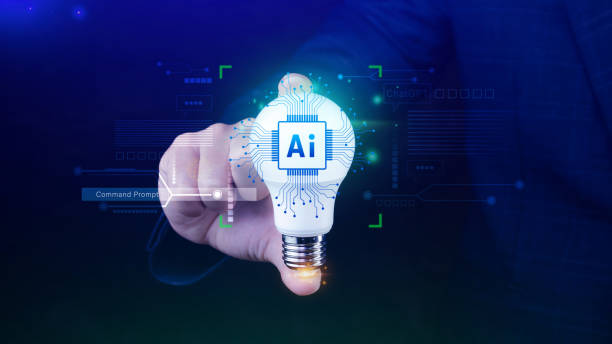
AI robots in everyday life
AI robots are increasingly present in our everyday lives and help us perform various tasks.
These robots can be used in various fields such as home, work, transportation, and entertainment.
Some of the most important applications of AI robots in everyday life are:
- Home: AI robots can do household chores, such as cleaning, cooking, and caring for children and the elderly.
Robotic vacuum cleaners and voice assistants like Amazon Alexa are examples of AI robots that are used in homes. - Workplace: AI robots can do administrative and clerical tasks, such as answering emails, scheduling meetings, and managing documents.
Chatbots and virtual assistants are examples of AI robots that are used in the workplace. - Transportation: AI robots can automatically drive cars and manage traffic.
Self-driving cars and intelligent navigation systems are examples of AI robots that are used in transportation. - Entertainment: AI robots can play games, create music, and produce movies.
Intelligent video games and musician robots are examples of AI robots that are used in entertainment.
The use of AI robots in everyday life can lead to increased comfort, reduced stress, and time savings.
However, it is necessary to address the security and privacy issues related to the use of these technologies to prevent their misuse.
| Field | AI Robot Example | Application |
|---|---|---|
| Home | Robotic vacuum cleaner | Cleaning the house |
| Workplace | Chatbot | Answering questions |
| Transportation | Self-driving car | Automatic driving |
| Entertainment | Intelligent video game | Providing entertainment |
Did you know that your company’s website is the first point of contact for 75% of potential customers?
Your website is the face of your brand. With Rasaweb’s corporate website design services, create an online presence that builds customer trust.
✅ Creating a professional and lasting image of your brand
✅ Attracting target customers and increasing online credibility
⚡ Get a free consultation from Rasaweb experts!
How to build an AI robot
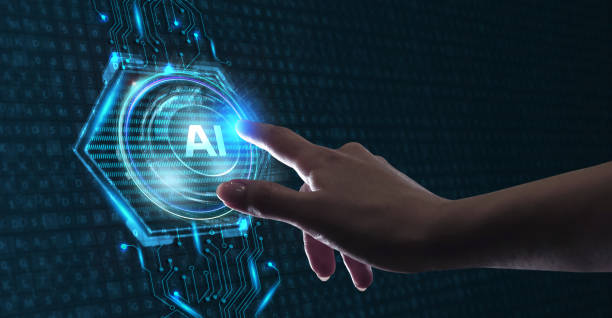
How to build an AI robot
Building an AI robot is a complex and multi-step process that requires knowledge and expertise in various fields such as robotics, artificial intelligence, programming, and electronics.
However, with the use of available tools and resources, a simple AI robot can be built.
The main steps in building an AI robot are:
- Define the goal: First, you need to define the goal of building the AI robot.
What is your robot supposed to do? What problems does it solve? Answering these questions will help you design and build the robot more effectively. - Hardware Selection: The robot’s hardware includes electronic, mechanical, and sensor components.
You need to choose hardware that is compatible with your goal and budget.
Some of the main hardware components include: microcontroller, motors, sensors, battery, and robot body. - Software Selection: The robot’s software includes control programs and artificial intelligence algorithms.
You need to choose software that is compatible with your hardware and allows the implementation of artificial intelligence algorithms.
Some of the popular software for building AI robots include: Arduino IDE, Raspberry Pi OS, and TensorFlow. - Programming: You need to write control programs and artificial intelligence algorithms for your robot.
This requires programming knowledge.
You can use various programming languages such as C++, Python, and Java. - Testing and Optimization: After building the robot, you need to test it and optimize its performance.
This includes testing the sensors, motors, software, and artificial intelligence algorithms.
You need to identify problems and fix them so that the robot works correctly.
Building an AI robot can be a challenging and enjoyable experience at the same time.
With patience and perseverance, you can build an AI robot that helps you perform various tasks.
AI Robot
Ethical and legal issues related to AI robots
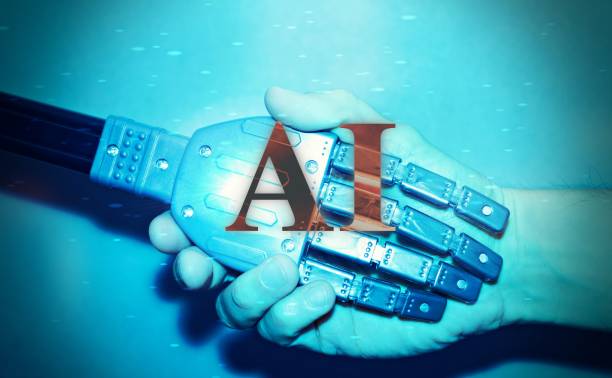
Ethical and legal issues related to AI robots
The widespread use of AI robots has raised new ethical and legal issues that need to be addressed.
These issues include accountability, privacy, security, and discrimination.
Some of the most important ethical and legal issues related to AI robots are:
- Accountability: If an AI robot causes damage, who will be responsible? The robot’s manufacturer, the robot’s user, or the robot itself? Answering this question is difficult and requires the development of new laws and regulations.
- Privacy: AI robots can collect a lot of information about users.
This information can include personal information, habits, and preferences.
How can users’ privacy be protected against the unauthorized collection and use of this information? - Security: AI robots can be vulnerable to cyber attacks and be hacked.
This can lead to serious damage to individuals and organizations.
How can AI robots be protected against cyber attacks? - Discrimination: Artificial intelligence algorithms may be discriminatory and provide unfair results.
This can lead to discrimination against certain groups of people.
How can discrimination in artificial intelligence algorithms be prevented?
To resolve these ethical and legal issues, cooperation between artificial intelligence experts, lawyers, policymakers, and the general public is needed.
Appropriate laws and regulations must be developed that protect the rights and privacy of individuals and ensure the responsible and safe use of AI robots.
Frequently Asked Questions
| Row | Question | Answer |
|---|---|---|
| 1 | What is an AI robot? | An AI robot is a machine that is capable of understanding, reasoning, learning, and problem-solving and can perform complex tasks with relative autonomy. |
| 2 | What are the most important applications of AI robots? | The main applications include industrial production, customer service (chatbots), medicine and surgery, self-driving transportation, space exploration, and military affairs. |
| 3 | What is the main difference between an AI robot and a regular robot? | A regular robot only follows programmed instructions, while an AI robot can learn from data, make decisions, and adapt to new environments. |
| 4 | How do AI robots learn? | They identify patterns and improve their performance through machine learning algorithms (such as deep learning, reinforcement learning) and processing vast amounts of data. |
| 5 | Can AI robots have feelings? | Currently, AI robots do not have real feelings in the human sense. They can imitate or recognize emotions, but they do not understand or experience them. |
| 6 | What are the current limitations of AI robots? | Limitations include the need for a lot of data, the inability to understand abstract concepts, the lack of real creativity, ethical issues, and the challenges of generalization in new environments. |
| 7 | What is the role of AI in the development of Humanoid robots? | Artificial intelligence helps humanoid robots walk, maintain their balance, understand their surroundings, interact with humans, and perform complex tasks. |
| 8 | How is the future of AI robots predicted? | It is predicted that AI robots will become smarter, more autonomous, and capable of performing more complex tasks in everyday life and industry, and their interaction with humans will increase. |
| 9 | Can AI robots replace all human jobs? | It is unlikely that all human jobs will be replaced. Robots will take over many repetitive and dangerous tasks, but jobs that require creativity, empathy, and ethical judgment will remain. |
| 10 | What ethical and social challenges are raised with the expansion of AI robots? | Challenges include issues related to privacy, data security, ethical decision-making by robots, the impact on employment, and accountability in case of errors. |
And other services of Rasa Web Advertising Agency in the field of advertising
Smart Advertising Campaign: A professional solution for analyzing customer behavior with a focus on intelligent data analysis.
Intelligent Data Analysis: A quick and efficient solution for improving SEO ranking with a focus on intelligent data analysis.
Smart UI/UX: A quick and efficient solution for user interaction with a focus on attractive user interface design.
Intelligent Website Development: An effective tool for user interaction by customizing the user experience.
Smart Brand Identity: Professional optimization to improve SEO ranking using real data.
And more than hundreds of other services in the field of internet advertising, advertising consulting and organizational solutions
Internet Advertising | Advertising Strategy | Advertorial Report
Resources
What is Artificial Intelligence and How Does It Work?
,What is a Smart Robot?🤖 Smart Robots
,What Do We Know and Not Know About Artificial Intelligence?
,What is Artificial Intelligence? (AI in Simple Language) | Data Science
? Are you ready to transform your business in the digital world? Rasa Web Marketing Digital Agency offers innovative solutions to achieve your goals with its expertise in various fields, including Responsive Website Design, search engine optimization and social media management. We help you attract more customers and grow your brand with a powerful online presence.
📍 Tehran, Mirdamad Street, next to the Central Bank, South Kazerun Alley, Ramin Alley, No. 6

